Crypto Academy / S4W7 - Homework Post for [yohan2on] The Governance of the TRON Ecosystem
On this occasion, I will join the incredible class of professor @yohan2on, where he tells us a little about the governance system of the TRON blockchain, a blockchain that has shown us once again the importance it has in the ecosystem, based on mainly in the speed and high scalability of your transactions, but behind all that, how does your governance system work?
If you want to know a little more, I invite you to join his wonderful class today.
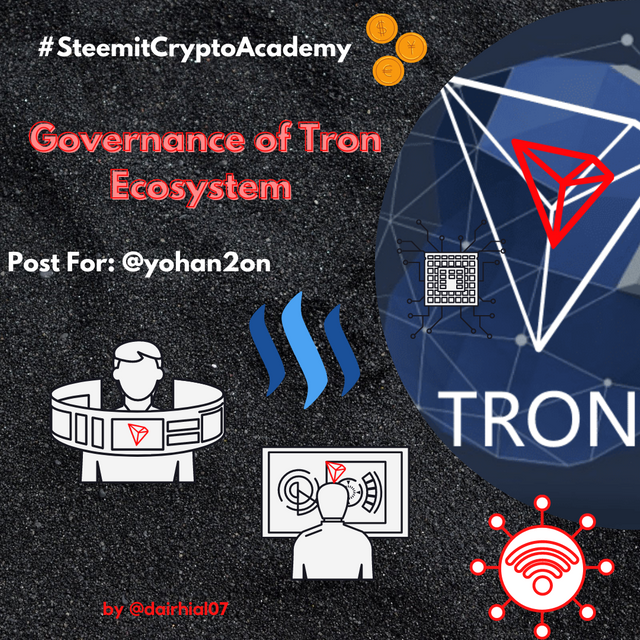

The TRON blockchain when it emerged in 2017, was created with the purpose of solving and replacing some problems that other blockchains were having, its developer Justin Sun mainly specialized in scalability and security problems, and since then it has been It has become one of the best blockchains that can operate under the crypto-assets ecosystem.
Characterized by its low commission on transactions, TRON has become the best option for millions of users to carry out their financial operations. Currently there are several DeFi in the market that are supported under this incredible blockchain, which contribute and help the economy of decentralized finance, such is the case of the renowned exchange DEX JustSwap.
It works with a wonderful third-generation consensus algorithm that helps the development and proper functioning of your network, which is better known as delegated proof of stake (DPoS), this consensus algorithm goes hand in hand with the TRON's blockchain governance system, which we will discuss in detail below:

1) ¿Who are the Super Representatives, SR Partners and A candidates? (The governance of the TRON ecosystem)

The good functioning and the wonderful structure that TRON blockchain has is due to all the work team with which it works, its governance system is a key and fundamental piece for this blockchain to work perfectly, but behind that there are people who work hard to make it. As it indicates in its consensus algorithm, there are delegates or witnesses who are in charge of creating blocks and verifying transactions within the network, but these delegates are chosen by a voting system, where they have You have to have or bet TRX for your participation, the more assets you have, the more opportunity you will have to remain as a delegator.
To participate by carrying out activities that help and contribute to the governance of TRON blockchain, there are a series of parameters, as well as established positions of higher and lower levels for your participation, in this case we have three stages with which the governance of TRON works to choose to their delegates or witnesses, who are qualified as follows:
• Super representatives (SR)
• Super representative partners (SRP)
• Candidates for super representatives (SRC)
Next I will explain the work of each of them:
🟢 Super Representatives (SR)
In the first stage we can find the super representatives, who are selected through a voting system so that they can participate in the governance of TRON blockchain, in this case only 27 super representatives will be selected who will participate actively for a period of six hours to perform operations on the network, such as verification and validation of blocks and transactions. In short, this means that only 27 super representatives are voted to elect, who have a maximum time to carry out their work, which consists of six hours, after those six hours the voting system is carried out again to elect them. .
It is a very flexible and broad mechanism that gives the opportunity for thousands of people to become super representatives of TRON blockchain, since their change is executed every six hours, which gives more opportunities for other super representatives to participate. However, we must know that to participate in each round of super representatives, we must bet enough amount of TRX, the more we bet the better.
Now, once the super representatives are elected, they would receive as a reward for all the work they do on the network, an estimated payment for their good work and performance, which is a great initiative for millions of users to apply and contribute with the governance system of this blockchain. The rewards obtained by the super representatives are stipulated according to the number of blocks that are created in the network, and for each block produced they give a total of 16 TRX, and as we know in the TRON blockchain, one block is generated each 3 seconds, therefore, we can say that in six hours the SR receive a number of very generous rewards for their good work.
The participants in the network who decide to vote for the delegators, must also bet their TRX for this, this step is very simple and not at all tedious, we also have the advantage of seeing the profile and data of the SR to which you We are going to grant our vote, which gives us a little more peace of mind and confidence in knowing who we are voting for to be in charge of carrying out operations in the governance system of this blockchain. We must remember that the super representatives play a very fundamental role within the TRON network, the proper functioning and performance of all operations depend on them, therefore, the voting mechanism is also essential in a decentralized system to help choose. SRs have a fairer and more balanced network.
A very important fact, and that is that the SR can receive a percentage of reward obtained by the SRP.
🟢 Super Representative Partners (SRP)
In the second stage we have the super representative partners, who also play a fundamental role in the governance of TRON, but not the same as the SR, in this case the super representative partners are those that fall within the range of 100 positions, that is, from 28 and below they become super representative partners. In the same way, they are also voted and elected by participants in the network who must bet their TRX for it.
The role of the SRP is to actively participate in the processes that are carried out to improve the governance of the blockchain, since if for any reason an error occurs or they must choose something that is better for their network, the super representative partners will have active participation to vote and choose the best options, since a decentralized network is based on that. This means that SRPs do not validate or process blocks, since this task is only for SRs, therefore we must be very clear about this part.
In this case, the rewards obtained by the super representative partners are totally different from the previous one, however, they can also obtain rewards for each block that is generated every three seconds on the network, as well as obtain rewards for voting. This also motivates and encourages SRPs to apply and be able to participate in decisions that have to do with the governance of this blockchain while obtaining rewards for it, since their participation also costs and is worth a lot.
However, in a hypothetical case that an SR abandons its activities of production and validation of blocks and transactions for a stipulated time, the network would act automatically and replace it with a super representative partner. If the SR decides to re-enter the six-hour period, the network would not support it, therefore, it must wait until the next round.
🟢 Super Representative Candidates
In the third stage, we have the super representative candidates, which are determined in the range of 127, that is, it is the union of the super representatives with the super representative partners, which play a really important role for the governance of the TRON blockchain, thanks to them operations such as transaction packaging, as well as validation and creation of blocks are carried out. Each one specializes according to their rank and position, which I mentioned in detail above.
They share some notable characteristics:
• They are a fundamental part of the development of the TRON blockchain.
• As an incentive, they receive rewards for their activities carried out on the network.
• They must bet TRX to participate as SR or SRP, which are determined according to the number of votes they grant.
• Trabajan is a fair and totally decentralized network that is responsible for offering the best tools to users for the good of their finances.
We can see that both fulfill a totally different role, but both work with the same objective, which is to help with the governance system of this blockchain, therefore, we can see the great relevance that they have in the network, and the importance also of participating as voters to elect them.
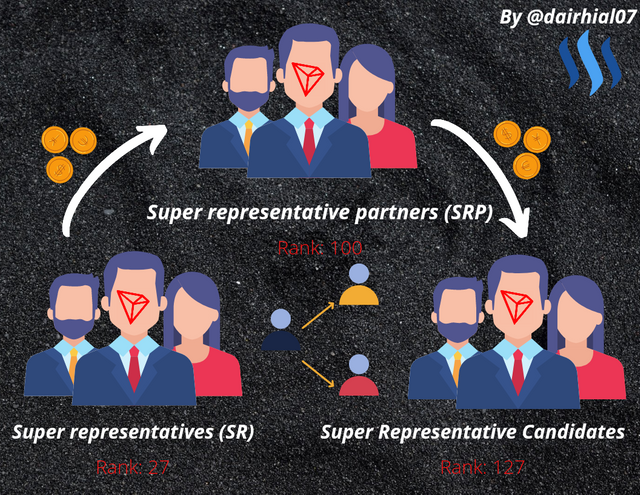
In the following image shown below we can see the rank of each delegator who participates in the governance of TRON;
• In the first case we have the super representatives, who are in the range of 27 in the voting system.
• In the second case we have the super representative partners, who rank from 28 to below, among them 100.
• And in the third case we have the super representative candidates, which are the total of the SRs and SRPs, that is, the ranking of 127.

2) What is the difference between POS and POS consensus mechanisms?

To fully understand the difference between the two algorithms, I will first discuss each one in detail:
🟢 (PoS)
In this case, we have the proof of stake algorithm, which was launched to the market in order to present faster and more efficient alternatives than other algorithms, to be more specific like PoW. Here the validators or nodes of the network are chosen randomly, and do not need to use large mathematical formulas to be able to validate and create good blocks in the network, which means that large computational resources are not used that affect the environment.
To participate as validators in PoS you must bet or have a large number of coins, although it is chosen randomly, you have a high chance of being if we have the largest number of coins saved. We will ask ourselves, What is the importance of this? Well, the saved coins ensure that the block validator does its job correctly, since if for any reason it decides to violate the network or create malicious attacks, it would lose absolutely all its coins.
Its level of scalability is also an important factor to deal with, since by not having to spend so much time deciphering mathematical puzzles, they make the transaction validation and verification process carried out quickly, the important thing is to have a sufficient number of coins. so that validators can get their work done. As expected, they also receive tokens as a reward for all the work they do on the network, but this will also depend on the amount of coins they have.
The possession of coins is the main factor of this consensus algorithm, it is also essential to be able to participate as a validator and to be able to carry out activities that help and improve the network. Security goes hand in hand with this, since the currencies that these validators have are put at risk if they consciously create an attack that could affect the network, therefore, we can say that it is a protocol that guarantees us security.
🟢 (DPoS)
As I already mentioned before, this is a third generation consensus algorithm capable of the proper functioning of highly scalable blockchains, it was launched on the market by its developer Daniel Larimer, one of the main creators of the wonderful Steemit platforms. Its main objective is to work through a broader and more flexible structure so that the nodes or validators can do their work quickly and efficiently.
To elect these nodes or validators, it is carried out through a voting system carried out by the voters who participate in the network, each validator has a rotation position, which changes every certain period of time. To participate as a node in the network, a large number of tokens must be wagered to be able to apply, then depending on the position you obtain you can be chosen to perform tasks such as confirming, validating and processing transactions and blocks on the network.
As part of an incentive, these delegates receive rewards for each job they do on the network, according to their rank and position. We must also remember that the community participants are the ones who elect the delegators, and if by any event the delegator violates a rule, he can be immediately expelled by the voters.
(DPos) is characterized by its high level of scalability, and to achieve that it must reduce the number of delegates that participate in the network, that is why they do not need to use high computing equipment that can often consume large amounts of energy, which causes a very negative impact on the environment. This means that the delegated proof of stake algorithm is completely ideal for the proper functioning of blockchains, currently there are several projects that are based on it, which have obtained incredible results.
🟢 Differences:
• DPoS is an improved version of PoS
• The choice of choosing the validators in the network are totally opposite, since in PoS it is done randomly and according to the amount of coins you have. On the other hand, in DPoS, it will depend on a voting system carried out by the participants in the network.
• To participate as a PoS validator, you must have as many coins as possible. In DPoS, you must bet or freeze tokens in order to participate and have a voting system chosen for you.
• The validators in DPoS are organized according to a rotation system. In PoS, the one with the longest development time on the network, and the one with the coins, are kept.
• Both of them get a reward in tokens for their active participation in the network, but the two get totally different rewards.
Each consensus algorithm has its different functions and objectives, but both work with the same vision, which is to allow validators or delegates to work on the network for its proper functioning. Something that we must highlight is that both algorithms do not work with large computational resources, which makes it have a positive impact on the environment.
Today there are many blockchains that have implemented these algorithms in their network, we have witnessed their proper functioning and the wonderful advantages that they offer them, therefore, both form an essential part of the cryptoactive ecosystem.
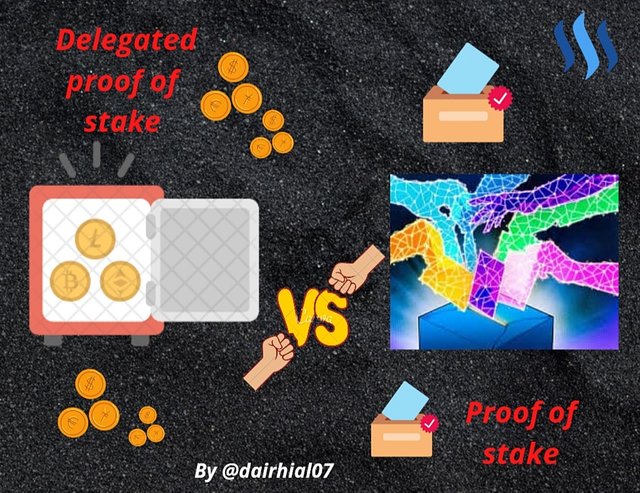

3) Write a Step by Step tutorial showcasing how to stake/freeze TRX and vote for SRs

🟢 How to freeze our TRX?
• This process is extremely simple and easy, for this we must enter our Tronlink wallet, and have TRX available to freeze them.
• When we open our wallet we can see a wide and simple interface to start operating, in this case, in the upper right corner there is an item that says "Freeze".
• We will click there, and it will take us immediately to another interface where we are going to freeze our TRXs.
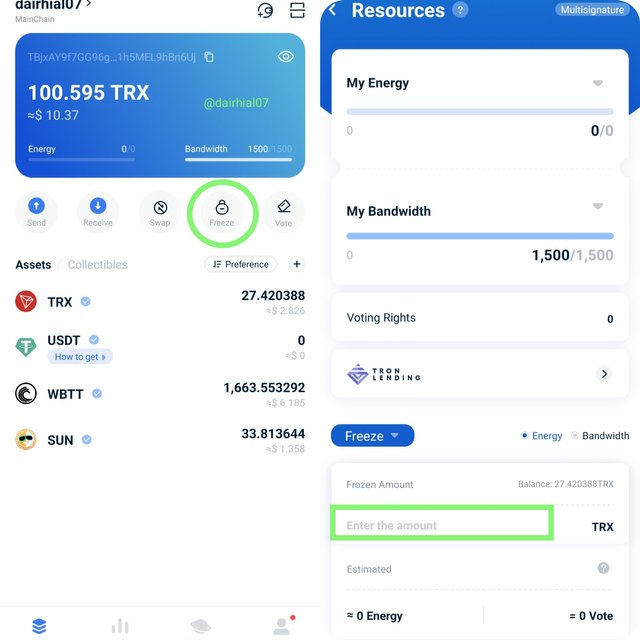
• In our second image we can see broad details about our energy, our bandwidth percentage, the number of votes we have available, among other tools.
• As I do not have votes, we must freeze them, in this case we are going to enter the amount we want to freeze, where it says "Enther the amount".
• In this case I entered 10 TRX, and finally we will click on Freeze.
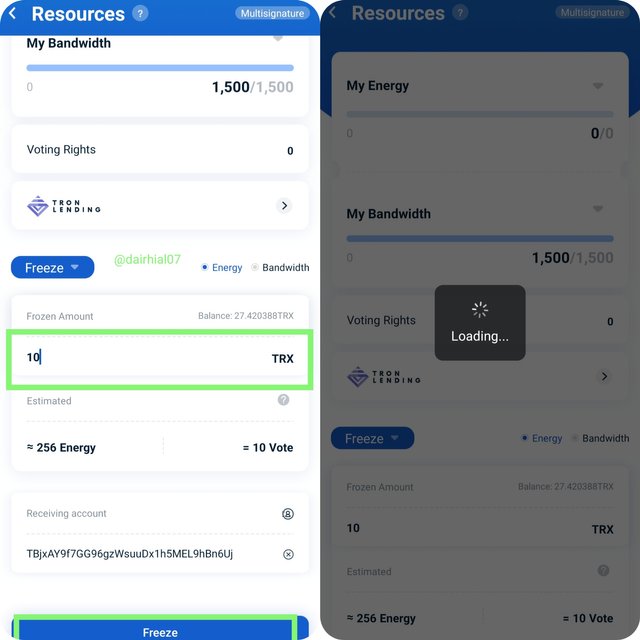
• Then a small interface will appear confirming our operation, and where we can see relevant details about it. How, for example, we can not charge us anything in commission, we can see the amount to freeze, etc.
• We will click on "Comfirm" and it will automatically ask us for our private key of our wallet to be able to finish the operation.
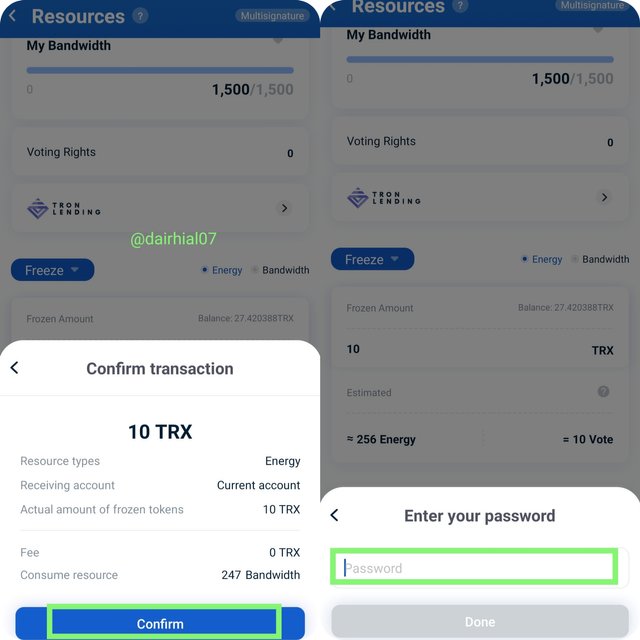
• Then we can see how our operation is performed, and to check that it was executed correctly we can see it in our history:
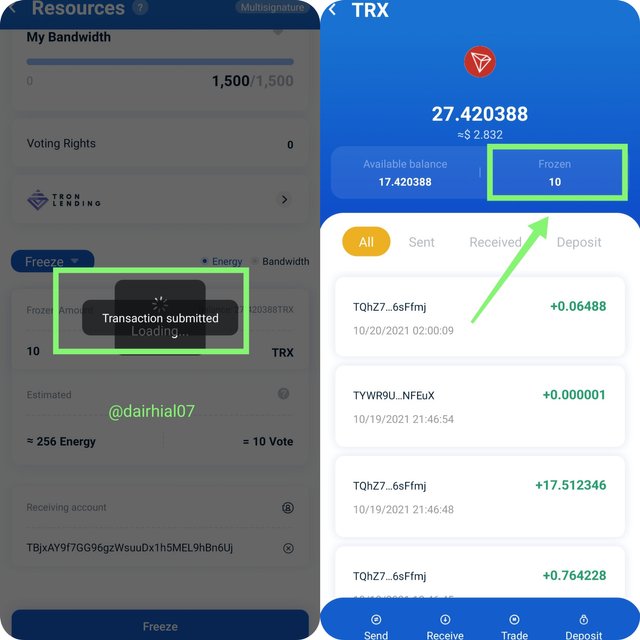
🟢 Vote for SR
To vote for the super representatives is extremely easy and simple, we just have to follow the following steps:
• On our main page of our Tronlink wallet, in the upper right corner we can find an item that says "Vote", we will click there.
• Then a broad interface will appear where we can see each of the SRs in a detailed list, as well as we can see the percentage of Yield they have.
• In this case, I will select Binance Staking to give it my vote.
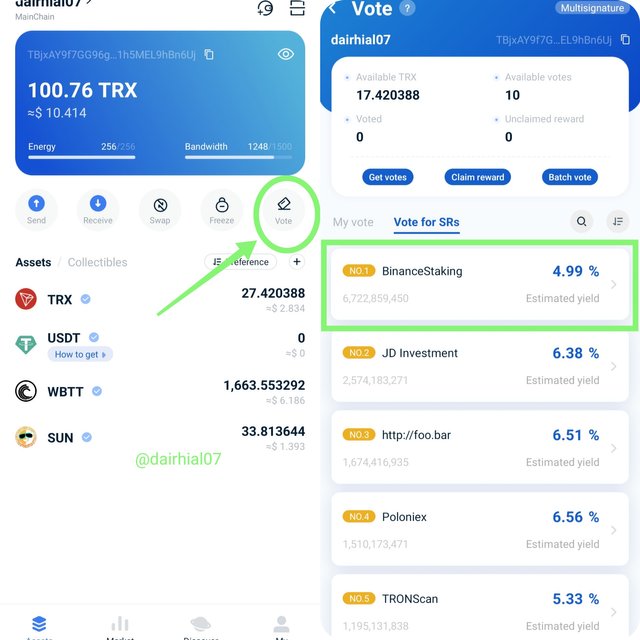
• Once we select it, we can see important details about its participation, such as: the number of votes it has, the percentage of votes accumulated, its website, among other details that are important to decide if we want to give it our vote. or not.
• Finally I clicked vote.
• Then we can see how an interface appears that confirms our operation, if we are completely sure we will click Confirm.
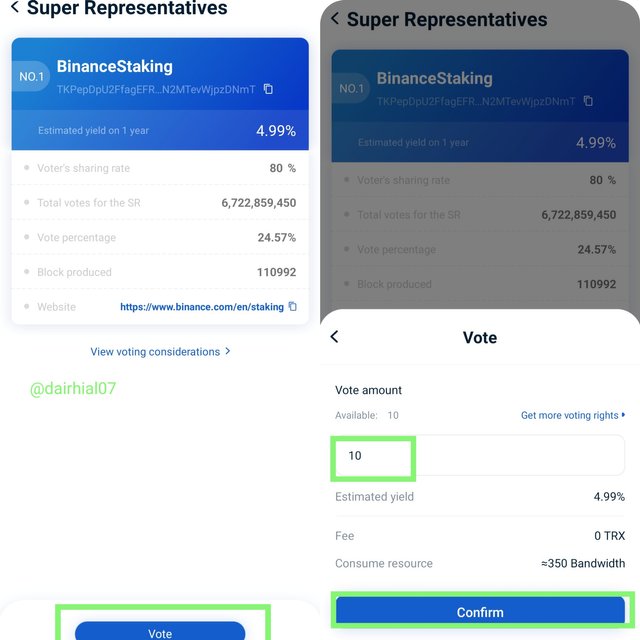
• Finally, they will ask us to enter our private key to complete our transaction.
• Then we successfully made our vote to Binance Staking, as we can see, we can see the number of votes that we have granted, which is a total of 10.
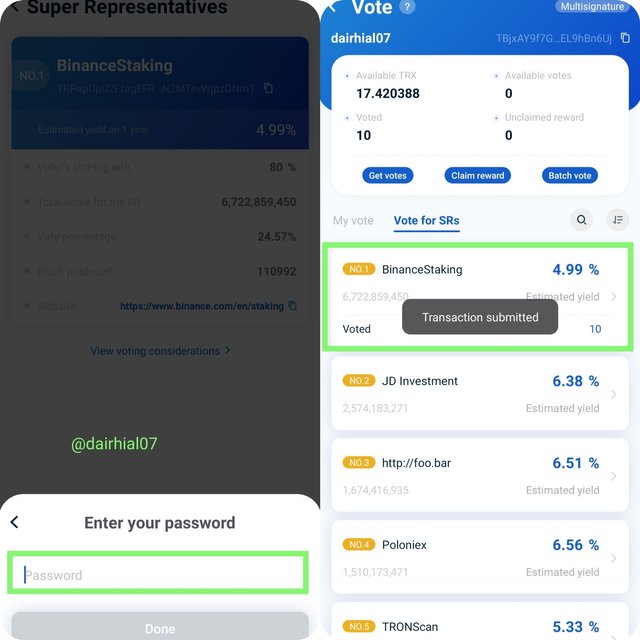
To conclude we can see how fast and easy it is to cast our votes to the super representatives who are in charge of carrying out the activities in the network and the governance of TRON blockchain. In this way we can actively participate to vote for SRs.

Conclusion

We have reached the end of our task, and we can see the importance of the governance of the TRON blockchain for its development, thanks to its consensus algorithm better known as delegated proof of stake, these mechanisms can be carried out successfully.
The importance of super representatives and super representative partners, make TRON governance maintain a balanced and fair system, through a voting system we can elect them in a period of 6 hours, we have already seen how easy it is. make our vows.
TRON continues to show us once again that its blockchain is one of the best currently in the ecosystem, its low commission in transactions and its high level of scalability, make millions of users around the world want to base their finances through it.
Decentralization is the most important factor of all, TRON is still in development, but I consider it to be a great blockchain that works with an incredible governance system, which protects and watches over the proper functioning of its network, to grant it to millions of users a flexible and comprehensive system for your finances.
I thank professor @yohan2on for this very interesting and important topic in the ecosystem of crypto assets, it was really a very instructive task where I could learn a little more about the wonderful TRON blockchain.
Until next time, it was a pleasure to participate.
Twitter: https://twitter.com/DairhiS/status/1450847364017688585?t=wTNBo7LzjvHIfGraiVeUIw&s=19
Hi @dairhial07
Thanks for participating in the Steemit Crypto Academy
Feedback
Total| 9/10
This is good work. Thanks for taking the time to learn about the governance of the Tron ecosystem.
Kindly, do not use the tag #club5050 in your articles if you have not powered up at least half of your total previous weekly steem rewards. For instance, for the past 7days, you cash out 187.583 steem and only powered up 58.962 steem which is less than what you cashed out.
Hola profesor, un saludo, el encendido tiene que ser de semanas anteriores? Porque ayer cobré una recompensa de 10 SBD, los cuales 5 SBD cambié para STEEM, como puede ver en mi historial, ahí sale claramente que cambié la mitad de mi recompensa para encender.
You should only use the #club5050 tag when your power-ups at least equal, or better exceed, your cash-outs and transfers away over the past 7 days.
Muchas gracias por la aclaración
But Sir I received no vote on #club5050